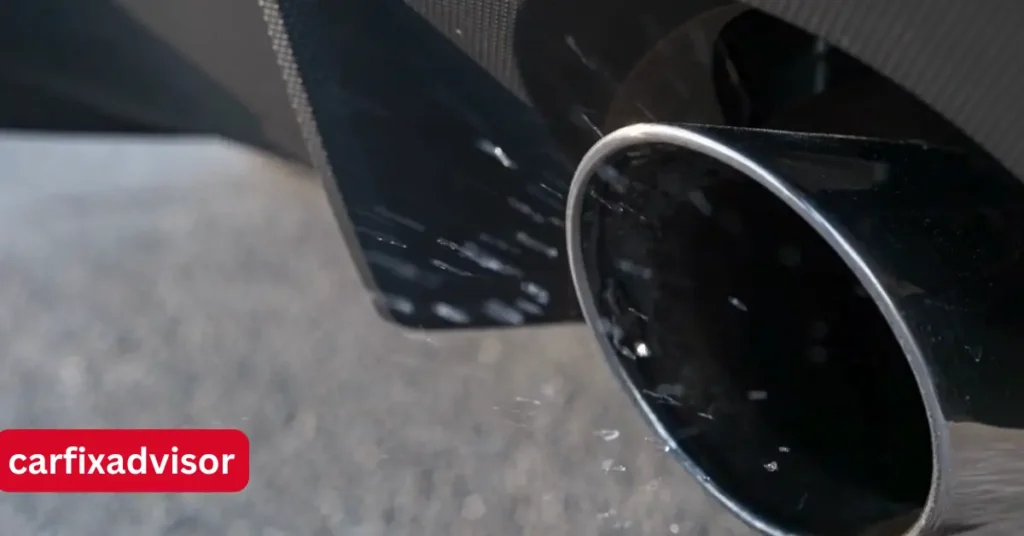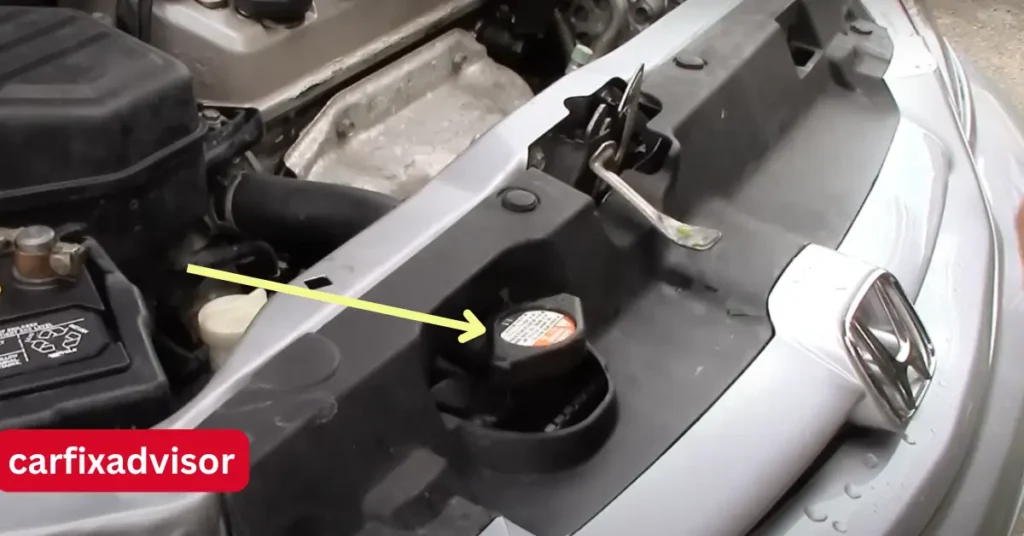Noticing water coming out of exhaust pipe from your car’s can be alarming, especially when it’s accompanied by a loss of coolant. While in some cases, this phenomenon can be perfectly normal, there are instances when it’s a sign of a deeper engine issue. In this article, we’ll explore why water appears in the exhaust, the connection to coolant loss, and how to diagnose and fix potential problems. Understanding these signs early can prevent serious engine damage and save you costly repairs down the road.
What Causes Water Coming Out of Exhaust Pipe?
Water coming out of the exhaust pipe isn’t always a cause for concern. In fact, it’s a normal byproduct of the engine’s combustion process. Let’s break down the basic mechanics and understand when this happens.
Combustion Process and Normal Water Production
During combustion, the engine burns fuel (gasoline or diesel) to produce energy. This process creates exhaust gases, which are expelled through the exhaust system. One of the byproducts of burning hydrocarbons (fuel) is water vapor, which can condense into liquid form, especially when the engine is cold.
-
The Process:
-
Start the Engine: When you start your vehicle, the engine begins to combust the air-fuel mixture.
-
Condensation Forms: As hot gases pass through the exhaust system, the temperature difference between the exhaust gases and the cooler exhaust pipe causes condensation to form.
-
Water Drips: This condensation eventually drips from the muffler or exhaust pipe, especially when the car is cold or hasn’t been running long.
If you see this happening in colder weather or shortly after you’ve started the vehicle, there’s nothing to worry about—it’s simply condensation evaporating as the engine warms up.
-
Why It’s Usually Normal
-
White Steam: In colder temperatures, the condensation turns to steam, which can appear as white vapor coming out of the exhaust. This is harmless and is simply the water vapor turning into gas as it’s expelled.
-
When It Stops: Once the exhaust system warms up and the engine reaches operating temperature, this condensation process typically stops, and you may notice no water dripping from the exhaust pipe.
However, when the situation changes and you observe a large amount of water or coolant loss, it may indicate an issue that requires attention. So, while small amounts of water from the exhaust are completely normal, excessive or unusual water and coolant loss could signal a problem.

When Water and Coolant Loss is a Problem
If you find that Water Coming Out of Exhaust Pipe and Losing Coolant, there are several potential issues at play. Let’s explore these scenarios in more detail.
1. Blown Head Gasket
A common culprit for water coming from the exhaust pipe and coolant loss is a blown head gasket. The head gasket seals the gap between the engine block and the cylinder head, ensuring that coolant, oil, and combustion gases stay where they should. If the head gasket fails, coolant can leak into the combustion chamber.
-
Symptoms:
-
Coolant Loss: You’ll notice a steady loss of coolant, and your coolant reservoir will empty quickly.
-
Water from Exhaust: A blown head gasket can allow coolant to enter the exhaust system, resulting in water being expelled from the exhaust pipe.
-
Engine Overheating: The failure to keep coolant inside the system can lead to engine overheating, which further damages the engine.
-
If you suspect a blown head gasket, the engine will often exhibit a sweet smell from the exhaust and may misfire. The coolant reservoir might have air bubbles, and the engine may overheat rapidly.
2. Cracked Cylinder Head
A cracked cylinder head can also lead to similar issues—water coming out of the exhaust and coolant loss. This happens when a crack forms in the cylinder head, allowing coolant to leak into the combustion chamber or exhaust system.
-
Symptoms:
-
Coolant in the Exhaust: Just like a blown head gasket, a cracked cylinder head can lead to coolant entering the exhaust system.
-
White Smoke: In some cases, you may notice white smoke coming from the exhaust, a telltale sign that coolant is being burned with the fuel.
-
A cracked cylinder head can result from an overheated engine or from age-related wear and tear.
3. Damaged Engine Block
In rare cases, if the engine block itself is cracked, coolant can escape into areas where it shouldn’t be, leading to coolant loss and potential water in the exhaust. This is a serious problem and requires immediate attention.
-
Symptoms:
-
Engine Misfire: You may experience a rough idle or loss of power, as coolant disrupts the combustion process.
-
Coolant Leaks: If there’s a crack in the engine block, coolant will leak into the combustion chamber or onto the ground, causing the engine to overheat.
-
This is often the result of severe engine overheating or external damage to the block.
4. Coolant Leak in the Exhaust System
Another possibility is a coolant leak in the exhaust system itself, usually due to a damaged radiator or cracked coolant hose. This may cause coolant to flow directly into the exhaust system, leading to water droplets appearing at the exhaust.
-
Symptoms:
-
Unusual Water: The water coming from the exhaust pipe might not be clear. Instead, it could be tinged with a green or orange color, which indicates coolant.
-
Coolant Loss: You will notice your coolant levels dropping, and the car may overheat if the coolant system is compromised.
-
5. Excessive Engine Condensation
In some cases, excessive condensation can accumulate in the exhaust system, especially if the vehicle is used for short trips where the engine doesn’t have time to warm up. This excess water can drip from the exhaust, leading to the appearance of water loss.
-
Symptoms:
-
Persistent Drips: Water continues to drip from the exhaust even after the engine has warmed up.
-
No Coolant Loss: There is no drop in coolant levels, indicating that the issue is likely just condensation and not a coolant leak.
-
How to Diagnose the Problem
If you notice water coming from the exhaust and a loss of coolant, it’s essential to identify the underlying issue. Follow these diagnostic steps to pinpoint the problem:
1. Check Coolant Levels
Start by checking your coolant levels. If your coolant reservoir is significantly low, this is a clear indicator that coolant is being lost somewhere in the engine. Pay attention to the color of the coolant. If it’s green or orange, it’s a sign that it’s coolant, and not just water, being expelled from the exhaust.
2. Examine the Exhaust for White Smoke
White smoke coming from the exhaust, especially when the engine is cold, can be a sign of coolant leaking into the combustion chamber. If the smoke persists after the engine reaches operating temperature, it could indicate a blown head gasket or a cracked cylinder head.
3. Check the Oil for Contamination
A common sign of a blown head gasket or cracked cylinder head is contamination of the engine oil. Remove the oil filler cap and check for a milky or creamy substance. This is a clear sign that coolant has mixed with the oil, which can lead to severe engine damage if not addressed.
4. Perform a Compression Test
A compression test can help determine whether there’s a leak in the engine’s cylinders. A mechanic will use a gauge to check the compression in each cylinder, and a significant loss of compression in one or more cylinders is a strong indication of a blown head gasket or cracked cylinder head.
5. Look for Coolant Leaks
Visually inspect the engine for any coolant leaks. Check the radiator, hoses, and coolant reservoir for signs of damage or cracks. Leaking coolant can find its way into the exhaust system, causing the water to come out of the exhaust pipe.
How to Fix Water Coming Out of Exhaust Pipe and Losing Coolant
Once you’ve diagnosed the issue, the next step is addressing it. Here are potential solutions for each scenario:
1. Repairing a Blown Head Gasket
If you have a blown head gasket, the engine will need to be disassembled to replace the gasket. This is a labor-intensive and expensive repair, but it’s crucial for preventing further engine damage. Your mechanic may also need to check the cylinder head for cracks to ensure that it’s not damaged.
-
Solution: Replace the head gasket and check for damage to the cylinder head. Reassemble the engine and refill the coolant system.
2. Fixing a Cracked Cylinder Head
A cracked cylinder head often requires a full replacement, although in some cases, the cylinder head can be repaired if the crack isn’t too severe. A mechanic will assess whether a repair is possible or if a replacement is necessary.
-
Solution: Replace the cracked cylinder head or repair it if feasible. This may also involve replacing the head gasket to ensure a proper seal.
3. Engine Block Repair or Replacement
If the engine block is cracked, you’ll need to replace it. This is one of the most expensive repairs, as it involves removing the engine from the vehicle and replacing the entire block. This is a rare issue, but it’s possible in cases of severe overheating or external damage.
-
Solution: If the engine block is cracked, replacing it is usually the best option. The engine will need to be disassembled, and all components should be inspected for additional damage.
4. Fixing a Coolant Leak in the Exhaust System
If coolant has leaked into the exhaust system due to a damaged hose or radiator, the repair is typically simpler. Replacing the damaged hose or repairing the radiator should resolve the problem. However, the exhaust system will need to be checked for damage or rust caused by the coolant leak.
-
Solution: Replace any damaged coolant hoses or radiator. Check the exhaust system for corrosion and replace any parts if necessary.
5. Addressing Excessive Condensation
If excessive condensation is the issue and the engine is used for short trips, the solution is relatively simple. Allow the engine to warm up fully before driving, or consider taking longer trips that give the engine time to reach its optimal temperature. If the water is just condensation, this issue will resolve itself as the engine warms up.
-
Solution: Allow the engine to warm up properly or take longer trips to ensure the engine reaches optimal temperature.
Preventing Future Issues
Once you’ve fixed the issue, it’s essential to take steps to prevent it from happening again. Here are some tips to keep your vehicle running smoothly and avoid water in the exhaust or coolant loss:
1. Regular Maintenance
Perform regular maintenance on your vehicle to prevent coolant leaks, overheating, or other issues. Regular oil changes, coolant checks, and inspections of the exhaust system can help keep everything in good working order.
-
Tip: Follow your vehicle’s maintenance schedule to ensure your engine is running at peak performance.
2. Monitor Coolant Levels
Check your coolant levels regularly to ensure that the system is functioning properly. If you notice a sudden drop in coolant, investigate for leaks or other issues that might be causing coolant loss.
-
Tip: Keep track of coolant levels and top up as needed. If the problem persists, get your vehicle inspected by a professional mechanic.
3. Avoid Overheating
To prevent damage to the engine, always monitor the temperature gauge. Avoid driving if the engine is overheating, as this can cause significant damage to the head gasket or cylinder head. If your vehicle begins to overheat, pull over immediately and allow it to cool down before continuing.
-
Tip: Keep an eye on the engine temperature and pull over if it starts to overheat to prevent further damage.
Final Thoughts
Water coming out of exhaust pipe and losing coolant can be concerning, but with the right knowledge and timely action, most issues can be resolved. Always monitor your vehicle’s performance and look out for signs of engine trouble. If you ever feel unsure about what’s happening under the hood, don’t hesitate to take your car to a qualified mechanic for a thorough inspection.
Keeping your engine well-maintained not only ensures it runs smoothly but also extends its lifespan. Stay proactive, and you’ll avoid major headaches and costly repairs in the future.

